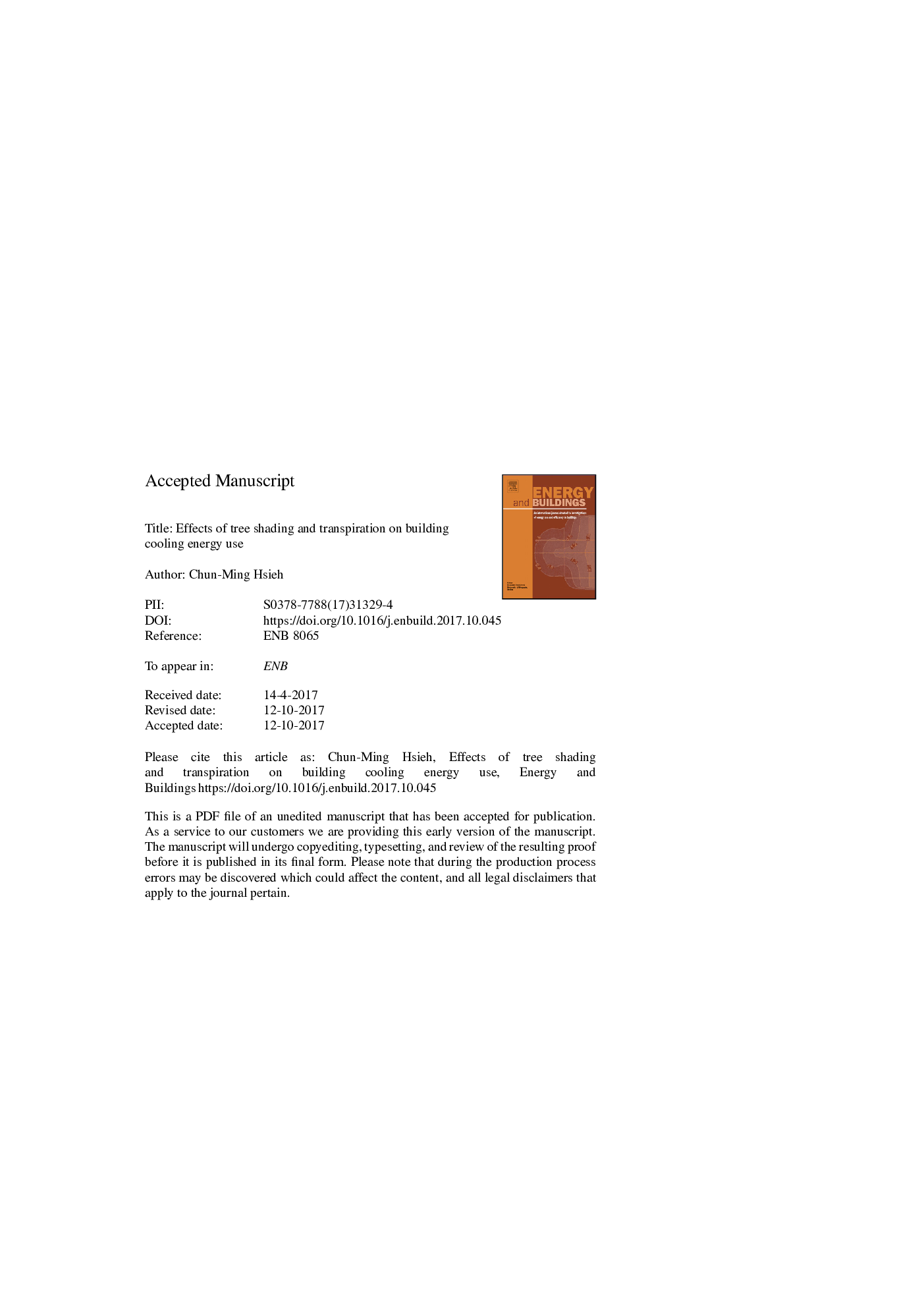| کد مقاله | کد نشریه | سال انتشار | مقاله انگلیسی | نسخه تمام متن |
|---|---|---|---|---|
| 6729244 | 1428931 | 2018 | 40 صفحه PDF | دانلود رایگان |
عنوان انگلیسی مقاله ISI
Effects of tree shading and transpiration on building cooling energy use
ترجمه فارسی عنوان
اثر سایه اندام و تناوب درخت در استفاده از انرژی خنک کننده ساختمان
دانلود مقاله + سفارش ترجمه
دانلود مقاله ISI انگلیسی
رایگان برای ایرانیان
ترجمه چکیده
استفاده از انرژی خورشیدی ساختمان به علت روند افزایش آن با نرخ بهره متناسب با کل مصرف مستقیم انرژی در مناطق شهری امروزه موضوع داغ تحقیقات ساختمانی است. سبز سازی شهری به عنوان یک اقدام معقول و موثر در کاهش بار خنک کننده ساختمان توجه جدی را جلب کرده است، گرچه کمبود اقدامات کمی برای اعمال ایده کلی به یک سایت یا ساختمان خاص وجود دارد. این مطالعه به این مسئله پرداخته است. اثر خنک کننده درختان در اطراف ساختمان ها و تأثیر ویژگی های درختی بر کاهش بار بار خنک کننده، با استفاده از اندازه گیری های مکانیکی و سرعت درخت درختان، اندازه گیری شد. با ادغام رویکردهای اندازه گیریهای محیطی از ویژگی های محیطی و محیطی به شبیه سازی انرژی پالس از استفاده از انرژی ساختمان، اثرات خنک کننده درختان به علت سایه انداختن و تغییر در ساختمان ها، مورد سنجش و بررسی قرار گرفت. چهار سناریو بر اساس ویژگی های درختی مختلف برای اندازه گیری تأثیر درختان بر صرفه جویی در مصرف انرژی ساختمان طراحی شده است: سناریو 1 با شرایط بی نظیر، سناریو 2 با شرایط موجود درختان در مورد شهر نانجینگ، سناریو 3 با شرایط سایه دار بیشتر و سناریو 4 با شرایط تنفسی بیشتر درخت. نتایج شبیه سازی نشان داد که در مقایسه با سناریو 1، سناریو 2 می تواند مصرف انرژی ساختمان را با 10.3 درصد کاهش دهد به این دلیل که مزایای سایه انداز و انتقال درختان موجود است. سایه انداز در سناریو 3 و نرخ انتقال بیش از حد در سناریو 4 می تواند مصرف انرژی ساختمان را به ترتیب با 15.2٪ و 12.4٪ کاهش دهد در مقایسه با سناریو 1.
موضوعات مرتبط
مهندسی و علوم پایه
مهندسی انرژی
انرژی های تجدید پذیر، توسعه پایدار و محیط زیست
چکیده انگلیسی
Building cooling energy use is regarded as the hot topic of building research due to its increasing trend at a rate proportional to the total direct energy use in urban areas nowadays. Urban greening as an effective countermeasure in reducing building cooling load has been attracting close attention although there is a shortage of quantitative measures for applying the general idea to a specific site or building. This study addresses this problem. The cooling effect of trees around buildings and the influence of tree characteristics on building cooling load reduction was quantified using microclimate field measurements and sap flow rate of trees. By integrating approaches of field measurements of microclimate and tree characteristics into EnergyPlus simulation of building energy use, the cooling effects of trees due to both shading and transpiration on buildings were quantified and discussed. Four scenarios were developed based on different tree characteristics for quantifying the influence of trees on saving of building energy use: Scenario 1 with treeless condition, Scenario 2 with existing trees condition in a case of Nanjing City, Scenario 3 with more tree shading condition, and Scenario 4 with more tree transpiration condition. The simulation results showed that compared to Scenario 1, Scenario 2 can reduce building energy use by 10.3% due to the benefits from existing trees shading and transpiration. More shading in Scenario 3 and a higher transpiration rate in Scenario 4 can reduce building energy use by 15.2% and 12.4%, respectively in comparison to that in Scenario 1.
ناشر
Database: Elsevier - ScienceDirect (ساینس دایرکت)
Journal: Energy and Buildings - Volume 159, 15 January 2018, Pages 382-397
Journal: Energy and Buildings - Volume 159, 15 January 2018, Pages 382-397
نویسندگان
Chun-Ming Hsieh, Juan-Juan Li, Liman Zhang, Ben Schwegler,
